Displaying items by tag: DBSC24
Dublin Bay 24 Wooden Boat–Building Provides Learning Through Working
#woodenboats – You can't make a news item about the wooden Dublin Bay 24 yachts into an add-on to another story. When we focused on October 11th on the challenges of maintaining classic wooden yachts, citing as examples the difficulties being faced with a rusting steel ketch and a 1902-built timber classic, we tail-ended it with an update about the continuing saga of the Dublin Bay 24s, those by now almost-mythical Mylne-designed beauties which have been gone from the bay for nigh on ten years. For our readers, this setting of priorities was a complete reversal of the proper order. They saw the Dublin Bay 24 as outshining everything else. W M Nixon tries to redeem the situation.
We soon learned that the Dublin Bay 24 is the story. Everybody seems to care about them. They were first envisaged in 1934, but didn't finally race as a class off Dun Laoghaire until 1947. They were immediately la crème de la crème. Yet within sixty years, they'd been spirited away to France to form the basis of a class of "accessible classic One Designs" which, after complete restoration, were to be owned or chartered for racing from a new resort on the French Riviera.
The recession put the dampeners on all that for a while, and the boats were reportedly put in store in a warehouse in Southern Brittany. But this past summer, rumours started circulating about one of the DB 24s being restored – effectively rebuilt in fact - to a classic standard which is way beyond the original straightforward and quite economical specification for the class. It turned out that all the rumours were true. And for us here at Afloat.ie, it confirmed that if you just hint at a mention of the Dublin Bay 24s, then people want to know everything.
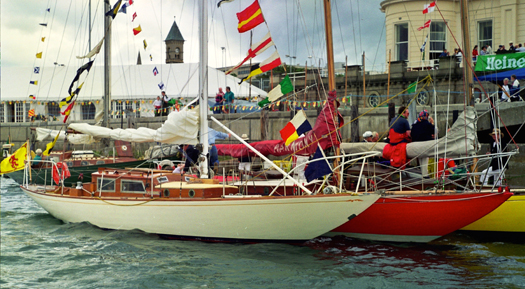
Periwinkle in Dun Laoghaire in July 1997 for the DB 24 Golden Jubilee Woodenboat Regatta – she is berthed outside sister-ships Harmony and Arandora. Photo: W M Nixon

Periwinkle as she is today, completely re-built except for her ballast keel, and sailing off La Turballe on France's West Coast in September
The "new" boat Periwinkle is based on the keel of the DB24 which never left her birthplace in Scotland, except to visit Dun Laoghaire in 1997 for the class's Golden Jubilee Regatta. But Periwinkle in the late summer of 2014 proved to be an exquisite bit of new work built by an organisation called Skol ar Mor, which is dedicated to preserving, developing and promoting classic boat-building and maritime skills. Naturally people in Ireland wondered why we can't have something similar in Ireland. However, it can be revealed that we do, not least in the form of a remarkable one-man operation in Galway. But first, let's try to unravel the story in France.
On the French Atlantic coast, due east of Belle Ile and midway between the Morbihan and the mouth of the Loire, there's a watery area at Mesquer on the edge of the Briere Nature Reserve. In this place, sea and land intertwine, and a traditional boatyard can have ample space, and easy access to the water, if the people involved are happy to wait for the tide to come up the nearest creek.

Classic boat builders of France. Mike Newmeyer (left) of Skol ar Mor where Periwinkle was re-built, and Cyril Benoist who is restoring Arandora at his own boatyyard in Kercabellec. Photo:Ian Malcolm
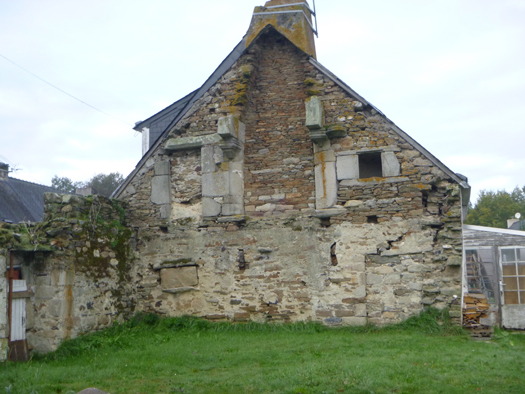
A curious confection. The gable wall of Mike Newmeyer's house near the Skol ar Mor boatyard. Photo: Ian Malcolm
It's here that Skol ar Mor has its attractive boat-building shed. Roughly translating as Breton for The School of the Sea, it's a sort of international commune which takes on apprentices for boatbuilding and shipwright's skills. Its President is the noted Francois Vivier, designer of highly individual wooden boats, while the Director is Mike Newmeyer, an energetic American who has taken to life in this region with such exuberance that his house in the midst of it all is an extraordinary confection created from recycled bricks and stonework some of which, in a former life, was part of a mediaeval castle.
Skol ar Mor is constantly on the prowl for interesting boatbuilding challenges which will both inspire and instruct its workforce, with the complete re-build of Periwinkle being one of its most ambitious projects. And as other traditional boatbuilders on both sides of the Atlantic have discovered, the thriving One Design scene in Ireland around the time the 19th Century was turning into the 20th has continued to provide a fertile design sourcebook, for one of the current Skol ar Mor projects is building a classic 14ft Dublin Bay Water Wag.
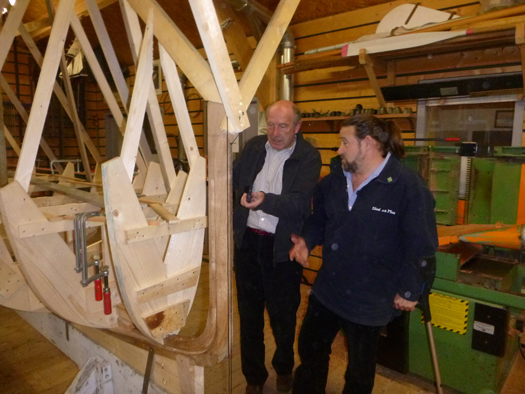
The new French Water Wag under construction – the stem was supplied by noted Irish classic boatbuilder Jimmy Furey of Leecarrow in Roscommon. Inspecting the work and exchanging ideas are Shannon OD measurer Noel Donagh and Mike Newmeyer of Skol ar Mor. Photo: Ian Malcolm
The word on the grapevine was that the new boat would be making her debut at the Paris Boat Show 2014, which is currently in full swing. But as a technical party from the Water Wag Association discovered when they went down to check out the project at the boatyard and take a few measurements some weeks back, something so boringly bourgeois as precise timekeeping is not really a feature of life in this secret region.
So not only is there no sign of a Water Wag in Paris this week, but there's no sign either of a traditional American Whitehall pulling boat, which was seen beside the Water Wag at a more advanced stage of construction in the hope she really might be ready to go to Paris instead. However, it certainly wasn't a matter of excessive agitation whether she did or not, and the Whitehall has also stayed on in Mesquer to be properly finished.
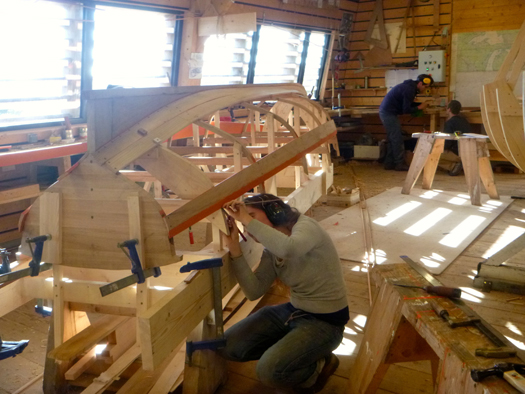
Planking under way on the carvel built Whitehall pulling boat at Skol ar Mor, which is being built upside, down while the Water Wag (below) is being built upright. Photos: Ian Malcolm
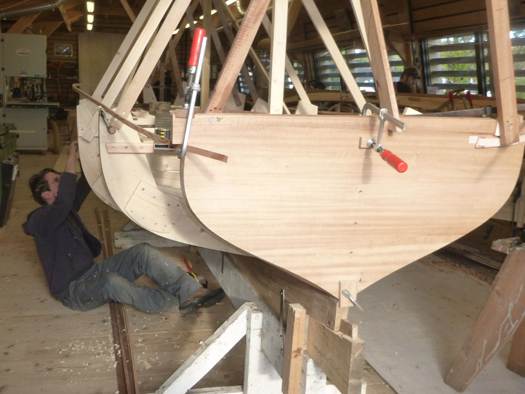
But then, as the Water Wags group of owners Cathy MacAleavy and Ian Malcolm, and advisory measurer Noel Donagh were to discover, the commune of Mesque soon begins to seem like the centre of the universe, while remote places like Paris become no more than incidental fixtures somewhere far inland along the road to the east. But before we go any further, what's this about an "advisory measurer"?
Well, it seems that although they've been in existence since 1903 in their present form, and as a class since 1887, the question of precise measurement in the Water Wags has always been given a fairly generous scope. But the Shannon One Designs, founded in 1922 when much of Ireland was distracted by a small Civil War, have always been interested in precise measurement to the point of obsession. And Noel Donagh, who lives on the shores of Lough Ree, is the Shannon OD Measurer – not a man to be trifled with when you've a classic one-design clinker-built sailing dinghy being built by strange folk in an even stranger part of France.
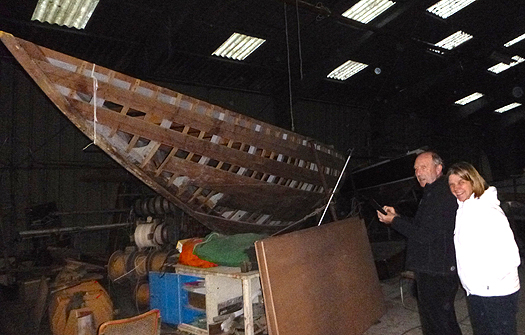
Noel Donagh and Cathy MacAleavy "discover" the DB24 Arandora undergoing restoration in Cyril Benoist's extensive shed in Kercabellec. Photo: Ian Malcolm
But the strict man from the Shannon One Designs, like the two owners from the Water Wags, found himself being drawn into a state of enchantment. Not only did they make a mutually useful input into construction details of the new boat, but they journeyed to Kercabellac nearby, where Cyril Benoist has his enormous boatshed. There, the main line of business is in looking after fleets of Requins, the popular French One Design keelboats, which look slightly like an International Dragon above water, but like nothing else on sea or land underneath - not even the sharks after which they're named. Yet it wasn't the oddity of the Requins which drew them in, but the fact that in a corner of the shed, the Dublin Bay 24 Arandora is being restored.
Arandora, forsooth. The Golden Yacht or the Banana Boat, depending whose side you're on. Dublin Bay 24 No 8. The youngest of them all by a year or two. Built in Alfred Mylne's own boatyard at Port Bannatyne on the Isle of Bute in 1949. For Col. W. A. C. Saunders-Knox-Gore DSO, Royal Irish Yacht Club and bar. You just couldn't make it up.
In her prime, Arandora was usually sailed by a crew of boisterous young ruffians, most of whom went on to achieve a certain level of respectability, and some even became Pillars of Society. Like everyone else, they were eventually drawn towards the world of more easily-maintained fibreglass boats as the hard-sailed Dublin Bay 24s began to show signs of age. And so, like her sisters, Arandora took the emigrant ship to France.
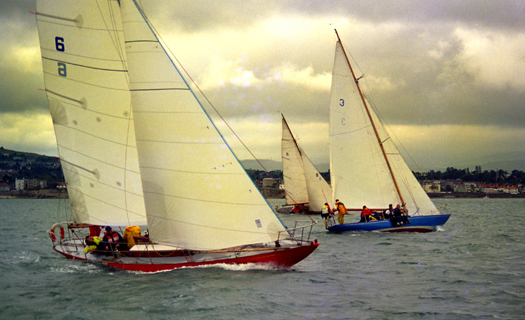
They're just gorgeous boats. The Dublin Bay 24s at the Golden Jubilee regatta in 1997 are (left to right) Harmony, Arandora and Euphanzel. Photo: W M Nixon
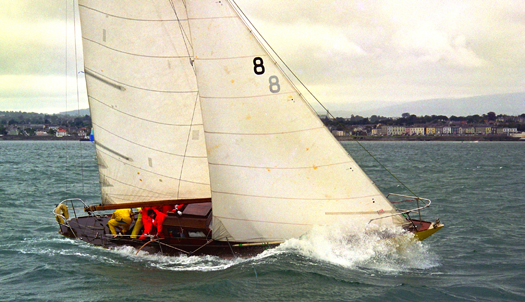
She was showing her age and making a drop of tea. Arandora racing at 1997's regatta, with the bilge pump outlet hose in action over the lee side. Photo: W M Nixon

Just wait till we try to change a light bulb. At the Golden Jubilee regatta, neither Arandora (left) nor Euphanzel were sailing short-handed. Photo: W M Nixon

Only the DB24 Harmony retained the original austere coachroof configuration which now features on the re-built Perinwinkle. Photo: W M Nixon

The Glen Class racing in 1997's Regatta. As the only surviving wooden keelboat class now in Dublin Bay, the Glens in 2014 have upped their game in the quality of their sails. Photo: W M Nixon
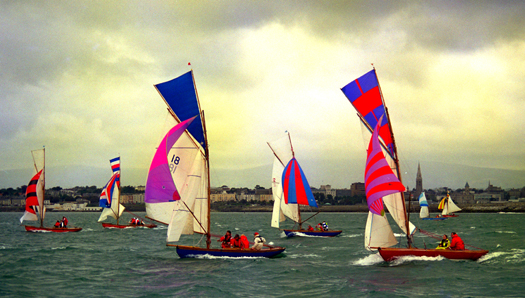
The visiting Howth 17s in full flight at the Golden Jubilee Regatta in 1997. The class has increased its numbers since then, while retaining their 1898 rig. Photo: W M Nixon
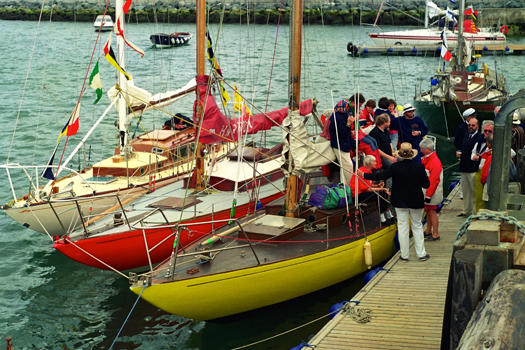
Party time for the Dublin Bay 24s celebrating their Golden Jubilee at the Royal Irish YC in July 1997 with Perinwinkle from Scotland berthed outside Harmony, and Arandora next the pontoon. Photo: W M Nixon
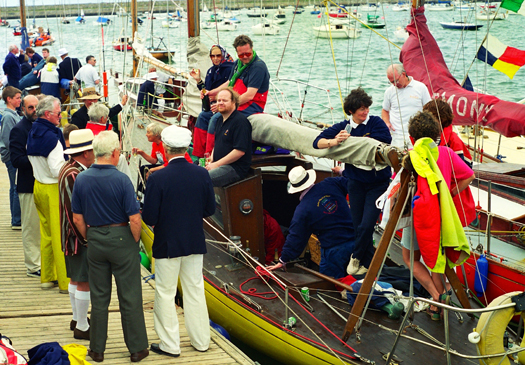
Only in Ireland would we think that this is a day for the Pimm's. In reality, the many who had sailed on her were taking their farewell from the golden-hulled Arandora at the regatta in 1997. Photo: W M Nixon
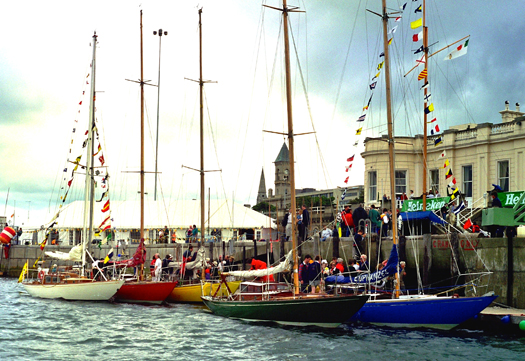
A last hurrah. Periwinkle, Harmony, Arandora, Fenestra and Euphanzel berthed together at the RIYC for the unique events of 1997. Photo: W M Nixon
For it had gradually become painfully clear that the Dublin Bay 24 Golden Jubilee Celebrations of July 1997, which expanded to become a major one-off Wooden Boat Regatta involving classics from both sides of Dublin Bay including Water Wags, Mermaids, Glens and Howth Seventeens, were leading inexorably to the last hurrah for the class. Within four years, the new Dun Laoghaire Marina was opened, then the Celtic Tiger was upon us, and ten years or so after their Golden Jubilee, all the 24s – including Perwinkle extracted from Scotland – had been shipped to France in the hope of a better future. People in Dun Laoghaire may indeed have felt a genuine attachment to them, but in the mood of the time their relevance was no longer dominant, while their maintenance costs were prohibitive.
In France with the recession upon the world, they were out of sight and out of mind, yet there were signs of hope. But whereas it was Perwinkle which was the first to re-emerge from the wilderness through a total re-build, Arandora is the first of the truly Dublin Bay boats to begin the long road to recovery, and in her case it will be a restoration rather than a re-build, for although there's much new material going into her, there's quite a bit of the original still in place.
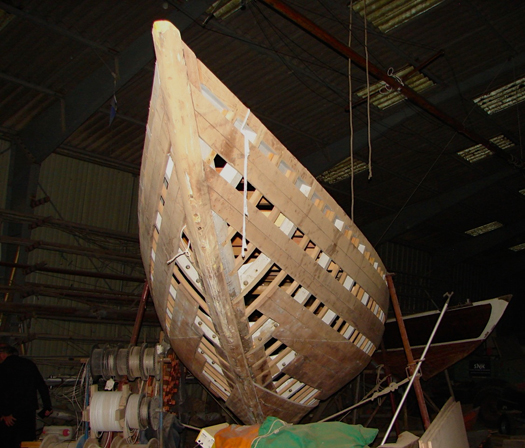
We've struck gold! The tiny area of topside enamel left on the stemhead of the boat undergoing restoration in Kercabellec indicates she is indeed Arandora. Photo: Cathy MacAleavy
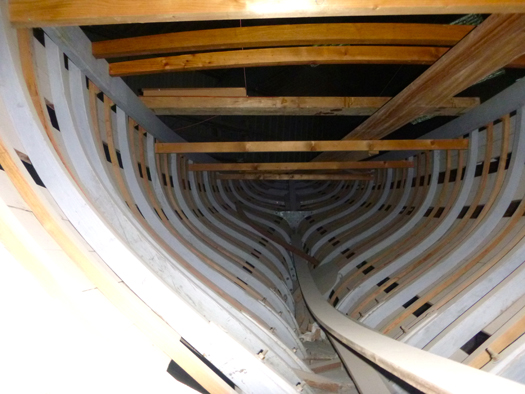
Arandora's restoration is verging into re-build territory, but it's reckoned enough of the orginal remains. Photo: Ian Malcolm
And at the very tip of her stem, the timber hasn't been entirely scraped back to the bare wood. There's still a tiny area of that unmistakable and unique hull colour. The golden boat lives on, in a place where classic boat-building skills are revered and central to a way of life. And the work on her restoration will now be monitored, for in May 2015 it's expected that a flotilla of Water Wags and maybe a Howth 17 or three will be trailed to the region to take part in the Morbihan Week for Classics & Traditionals, from Monday May 11th to Sunday May 17th 2015.
Meanwhile, for those who wonder that we don't have such community boatbuilding projects going on in Ireland, the answer is we do, it's just that they have their own special Irish flavour, and you have to seek them out. For instance, you'd be doing well, in driving west along the shores of Galway Bay from Barna into Connemara, to notice Jim Horgan's workshop. For it's a modest little place beside his house right on the road in Furbo, and dealing with the traffic is the priority, rather than finding a very special craftsman going abut his work.
For that's what Jim has been ever since he was signed up to a boatbuilding course at the age of 15 in Youghal. There, his father Joe was the electrician at the hospital, but supplemented his income by running boatbuilding courses in evening classes and on Saturdays. Boatbuilding was so much a part of the family's life that his son Jim was allowed to fabricate his age up to the lower limit of 16 so that he could do one of his father's courses. One way or another, he seems to have had boatbuilding as a steady stream of his life even while he took in moving to Galway in his day job as a teacher, and marrying Mary and setting up home in Furbo.
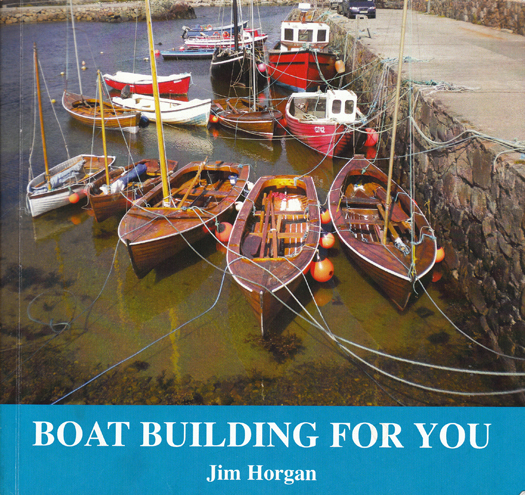
The cover of Jim Horgan's book on boatbuilding says it all. The Horgan-built boats featured on it in Spiddal harbour, with the white-hulled restored dinghy of Conor O'Brien's Saoirse (left), include in the front row (left to right) a new sister-ship of the Saoirse dinghy, a "sailing currach" known as the Galway Bay 16, a 19ft "Jollyboat Currach", and a 19ft rowing/sailing yawl. Beyond are another 19ft yawl and16ft sailing currach.
His father Joe had a no-nonsense approach to boat-building, and kept a notebook with sketches of his straightforward techniques. It's a path which Jim has followed, while developing it all into a handy little book which is the very soul of modesty, for it doesn't tell you where or when it was published, or indeed where you can get hold of a copy, yet it's a treasure trove of a whole way of looing at life and getting on with the job.
As Jim so neatly puts it, what he teaches is vernacular boatbuilding. Nothing too fancy, just a sensible approach based in real life with a practical timescale which makes satisfactory projects feasible within a manageable period. Sometimes a very manageable period – from his Youghal days, he includes this terse account:
"We built an 18ft salmon yawl with 16ft cedar strips in Youghal Co Cork in just two weeks. It had six solid frames instead of moulds. Clamping strips to these frames made the job very easy, and with lots of help we planked the boat in four days".

Jim Horgan in his workshop in Furbo with the Droleen/Beetlecat nearing completion. Photo: W M Nixon

Jim makes models too. He's here in his workshop with a classic Galway hooker. Photo: W M Nixon
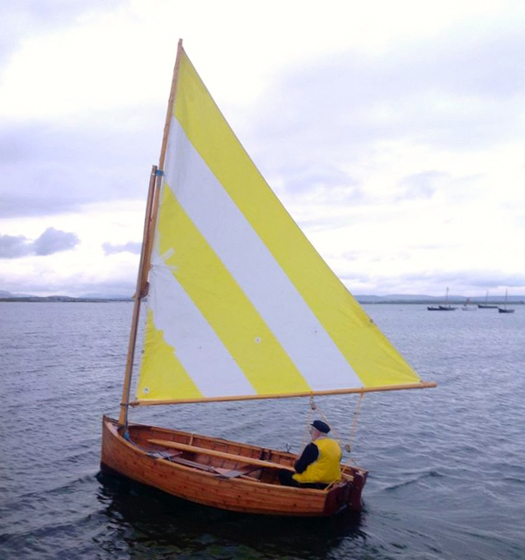
The boatbuilder himself sailing the new Droleen/Beetlecat at Lettermore in Connemara. Photo: Conall Horgan
The diversity of boats he is involved with is bewildering. He restored what is reputedly the dinghy used by Conor O'Brien on Saoirse, and built a sistership while he was still in the mood He has built boats up to 20ft gleoteogs, in fact his main work this winter is repairing a gleoteog he built many years ago. But in his boat-building claases, getting the job done and encouraging people by tangible results within a reasonable time-frame has always been the underlying philosophy.
Thus he states: "My present classes consist of three hours on a weeknight, and four hours on Saturday. Starting in October with templates and moulds to hand, any non-sailing boat should be planked by Christmas, and finished by 1st May".
That's that, then. It's no wonder you'll come across boats of distinctive Horgan origin all around Galway Bay. And he also built three Shannon One Designs for Lough Corrib. His most recent project in his own boatshed was building to the Bray Droleen design (see http://afloat.ie/blogs/sailing-saturday-with-wm-nixon/item/24479-the-irish-heart-is-still-in-wooden-boats). That had emerged from a design created quite a long time ago by O'Brien Kennedy in response to a demand from Bray to re-create the local dinghy class of a hundred years ago. But the boatbuilder of Furbo being Jim Horgan who finds ideas everywhere, the design has further evolved and he readily admits to inspiration from the American catboats, in fact he calls his Droleen – which has been sailing successfully in Connemara regattas – a Beetlecat.
Over the years, Jim Horgan has built up a following among those who have taken much from his boat-building classes, and got afloat as a result. Yet you won't often hear of him away from the shores of Galway Bay, and he is long gone from Youghal, But in his own special way, Jim Horgan is a maritime hero of our time.
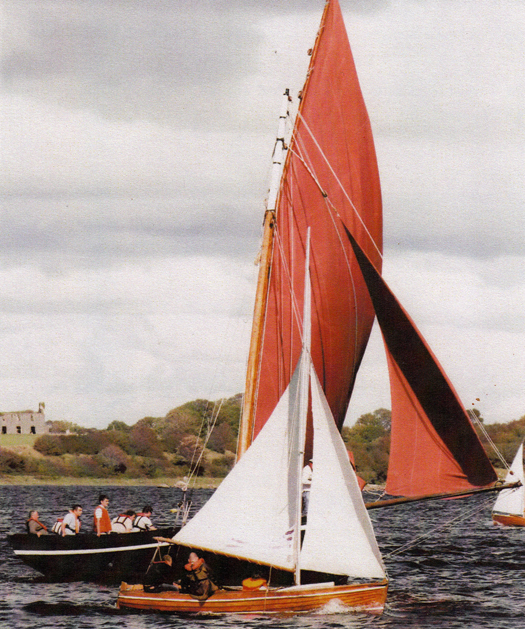
Mystery photo. It's Kinvara, and we know that is one of Jim Horgan's Galway Bay 16s in the foreground. But can anyone help us with identifying the mighty Bad Mor with her? Our Galway hooker expert tells us it could be one of three vessels, but he can't be sure which.
























































